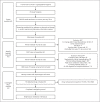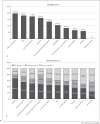Drug-Induced Hospital-Acquired Acute Kidney Injury in China: A Multicenter Cross-Sectional Survey
- PMID: 33824870
- PMCID: PMC8010232
- DOI: 10.1159/000510455
Drug-Induced Hospital-Acquired Acute Kidney Injury in China: A Multicenter Cross-Sectional Survey
Abstract
Introduction: Drug-induced acute kidney injury (D-AKI) is one of the important types of AKI. The incidence of D-AKI in China has rarely been studied.
Objective: This study aims to explore the disease burden, related drugs, and risk factors of D-AKI.
Methods: A nationwide cross-sectional survey was conducted in adult patients from 23 academic hospitals in 17 provinces in China. Suspected AKI was screened based on serum creatinine changes in accordance with the 2012 Kidney Disease: Improving Global Outcomes Clinical Practice Guideline for AKI, patients who met the diagnosis of hospital-acquired AKI in January and July of 2014 were defined. Suspected AKI was firstly evaluated for the possibility of D-AKI by pharmacists using the Naranjo Scale and finally defined as D-AKI by nephrologists through reviewing AKI clinical features.
Results: Altogether 280,255 hospitalized patients were screened and 1,960 cases were diagnosed as hospital-acquired AKI, among which 735 cases were defined as having D-AKI (37.50%, 735/1,960) with an in-hospital mortality rate of 13.88% and 54.34% of the survivors did not achieve full renal recovery. 1,642 drugs were related to AKI in these patients. Anti-infectives, diuretics, and proton pump inhibitors were the top 3 types of drugs relevant to D-AKI, accounting for 66.63% cumulatively. Besides age, AKI staging, severe disease, hypoalbuminemia, plasma substitute, and carbapenem related D-AKI were independent risk factors for in-hospital mortality of D-AKI patients.
Conclusion: In China, D-AKI has caused a substantial medical burden. Efforts should be made to pursue nephrotoxic drug stewardship to minimize attributable risk and improve the prevention, diagnosis, and treatment of D-AKI.
Keywords: Drug-induced acute kidney injury; Hospital-acquired acute kidney injury.
Copyright © 2020 by S. Karger AG, Basel.
Conflict of interest statement
The authors have no conflicts of interest to declare.
Figures




References
-
- Che ML, Yan YC, Zhang Y, Gu Y, Wang NS, Chen N, et al. [Analysis of drug-induced acute renal failure in Shanghai] Zhonghua Yi Xue Za Zhi. 2009;89((11)):744–9. - PubMed
-
- Wang Y, Cui Z, Fan M. Hospital-acquired and community-acquired acute renal failure in hospitalized Chinese: a ten-year review. Ren Fail. 2007;29((2)):163–8. - PubMed
-
- Yang L, Xing G, Wang L, Wu Y, Li S, Xu G, et al. Acute kidney injury in China: a cross-sectional survey. Lancet. 2015;386((10002)):1465–71. - PubMed
LinkOut - more resources
Full Text Sources
Other Literature Sources
Miscellaneous

